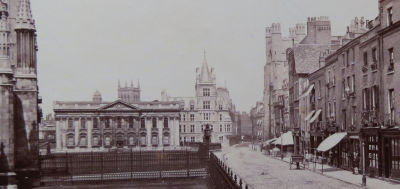
Registered Charity No. 289736
| Diary | Past Events | Fund Uses | JOIN |
| About Us | Constitution | Committee | Links |
 |
Friends Of Holy Trinity Church, Meldreth Registered Charity No. 289736 |
|||||||
|

One of the most difficult things to explain to visitors to Cambridge is the complex relationship between the University and the Colleges, which is only replicated in the similar structure existing in Oxford (also known in Cambridge as "The Other Place"!).
The University with its teachers and administrative staff is an independent foundation, funded by the fees from students and the many research grants that the high quality research carried out in the University Departments attracts from outside organisations.
The University being an ancient foundation, has accrued through the centuries, land and investments, such that in 2015 its endowment fund was about £2.3 billion (€2.9 billion) and it attracted some £400 million (€5.1 million) in research grants and contracts.
The 31 Colleges are also independent foundations, some of them comparatively rich (eg Trinity) and some relatively poor (eg Wolfson). All Colleges are owned by their Fellows. The combined endowments of the Colleges is estimated to be about £3.6 billion.
One of the reasons that some of the Colleges are so rich is that through the centuries their members, often drawn from wealthy families, were unmarried (due to religious considerations) and when they died without heirs they left their money and lands to their College. Foundation by royalty also boosted their initial wealth. King's College was founded by King Henry VI in 1441, St. John's by Lady Margaret Beaufort, mother of King Henry VII, in 1511, followed by Trinity by King Henry VIII in 1546. Trinity's foundation was partially financed by the money that King Henry VIII derived from the dissolution of the monasteries.
All students are members of both the University and a College (their "tribal home").
Membership and subsequently Fellowship of a College is by invitation to Officers of the University (lecturers) who teach subjects which are being studied by students members of the college. The students receive their lectures and practical sessions within the Departments of the University. Their College monitors their progress within the University and also arranges "supervisions", which are small group tutorials in the college given by the Fellows or Members of the College. Thus the students receive reinforcement of their studies and their College monitors progress and can arrange additional support if there is any indication that the student is not keeping up with their studies. They are also supported by a 'moral tutor'.
The Colleges are residential but they are more than hostels as clubs, choirs and societies are college-based. There are numerous inter-college sports competitions as well as between Cambridge and other Universities with team members drawn from college teams.
Unlike other Universities, the ethos in Cambridge is that if a student is accepted for a course, the University (& Colleges) have made the decision that the student is capable of achieving their objective, and will do whatever is necessary to make sure that they succeed. Thus the failure rate of around 3% is the lowest of any University in the UK (apart from possibly "The Other Place").
The majority of the Colleges have students studying the full range of disciplines, except for Churchill College where most of the students are studying science subjects.
It became evident in the 1960s that graduate study and research were becoming much more important than the previous concentration on undergraduate education. With the expansion of research, there was a concomitant increase in the number of academics senior in their field of study. Most of these were too specialised to be attractive to the Undergraduate Colleges as lecturers or tutors to their undergraduate students. The solution was the foundation of Colleges principally concentrating on housing graduate students, and at the same time providing Fellowships for many, but not all, senior researchers (there are still many senior researchers (c.20%)within the University who do not have College membership).
There are at present 6 Graduate Colleges, some of which also provide homes for mature undergraduate students.
For Undergraduates, applications are directly made to the Colleges where the prospective student is interviewed. By mutual agreement with the University, each College has an allocation of the number of studentships available within each discipline that they can accept.
For potential Graduate students their applications are made directly to the University departments teaching or researching the discipline that they wish to study. If accepted, they can indicate their Colleges of preference, but there is no guarantee that they will be accepted in one of their choices, but will, in any case, be allocated a College (usually a graduate College). Their College is their home and their Supervisors are members of the departments in which they are studying.
You can see, from my presentation, the expansion of both female and graduate student numbers since 1968, and that there is now virtually a balance by gender.
I hope that this document helps to explain the complex relationship between the University and Colleges.
Dr Brian D Cox